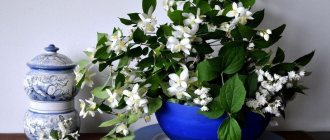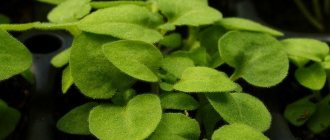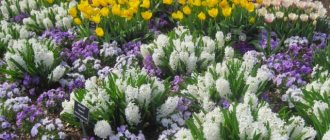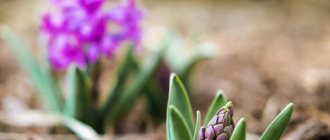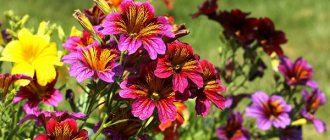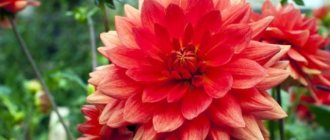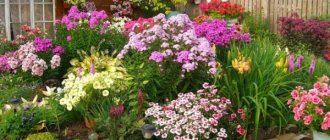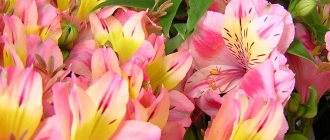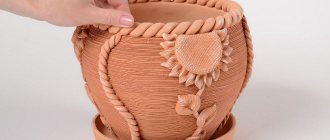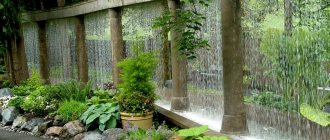Is this a perennial flower or not?
Since petunia belongs to the nightshade family, it is a perennial plant.
But in the conditions of our Russian winter it became an annual plant. The fact is that this flower comes from hot Brazil and is not adapted to frost. Therefore, petunia cannot overwinter in open ground. But there are ways to extend the life of this beauty.
In what cases is it annual?
Since the popularity of the flower spread throughout the world, breeders more than a century ago developed a variety of annual petunia using wild species:
- axillary petunia;
- violet petunia.
This hybrid is grown in cold countries. Therefore, in our country, the flowering of petunia ends with the first cold weather and every spring we have to grow petunia again from seeds or seedlings.
In what cases does a flower grow for more than one year?
As practice has shown, even those plants that are considered annuals can grow for more than one year. Of course, if you leave petunia in the flowerbed during the winter, you won’t be able to see it again next year.
But, if you transplant it into a pot for the winter and bring it into the house, then it is quite possible that it will be able to overwinter. Not all petunias are suitable for long-term cultivation, but only those whose seedlings developed naturally without accelerated forcing, and the seeds were sown in April, as nature intended.
Types and varieties
Depending on the design wishes, the buyer can choose from seeds of bush, ampelous, low-growing, multi-flowered, double and fantasy varieties. A special group consists of vegetative petunias. The peculiarity of plants of this type is that they can be propagated by cuttings.
The world of petunias is represented by many species and varieties
Depending on the design wishes, the buyer can choose from seeds of bush, ampelous, low-growing, multi-flowered, double and fantasy varieties. A special group consists of vegetative petunias. The peculiarity of plants of this type is that they can be propagated by cuttings.
Petunia classification
Numerous varieties are divided into multi-flowered and large-flowered. Multicolored - more bushy, with a flower of small diameter (only about 5 cm), formed on the stem in large numbers. These include grandiflora petunia, which is most suitable for growing under a roof, in special containers or in hanging pots. The main reason why petunia loses leaves is the effect of precipitation on the pampered leaves of the flower, so the plant feels best under a canopy or roof.
Multiple varieties of the popular flower are divided into 2 classes:
- petunia multiflora (multiflora)
- unpretentious, takes root well in garden conditions, loves warm sunlight). Although its flowers are not as decorative as large-flowered ones, they delight with an abundance of flowers of various shades. Varieties of multi-flowered petunia include Fantasy, Mirage and Plumcrystals. - Petunia grandiflora
is quite demanding in terms of conditions, it needs an increased temperature regime; under conditions of prolonged humidity, the flowers quickly lose their appearance, the diameter of the flowers is up to 13 cm. A striking representative of the class is petunia grandiflora, which has several expressive varieties. The large-flowered species include Hit Parade, Purple Pirouette and Pikoti.
The main differences between all varieties of garden specimens are the height, shape and size of the flower.
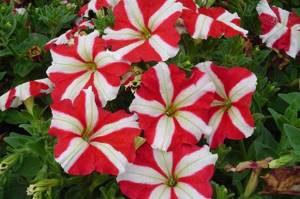
There are also less popular varieties of the plant - petunia floribunda. It can be called the “golden mean” between the two main varieties. Its flowers are resistant to rain, but are small in size. Therefore, it is grown mainly in large flower beds or flower beds.
Features of growing and caring for ampelous petunias
To grow ampelous petunia from seeds, it is important to select high-quality planting material supplied by a foreign manufacturer. It is better to sow seeds in the spring.
It takes 10 weeks for small-flowered varieties to bloom. Large-flowered plants begin to bloom 12 weeks after planting.
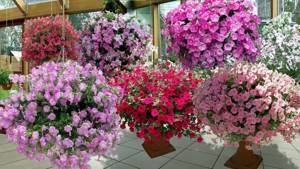
Ampelous petunia
The soil for planting should be loose, nutritious and thoroughly moistened. Before sowing, the seed material is soaked for 30-40 minutes. in a solution of potassium permanganate.
Step by step process:
Make holes on the surface of the bottom of the planting container through which excess water can escape. A small piece of pebbles or expanded clay is laid out at the bottom of the container. The thickness of the layer should not exceed 2 cm. Seeds are scattered on top of the poured soil. The container is covered with polyethylene material. There is no need to cover the seeds with a layer of soil. The pot is placed on a windowsill well lit by sunlight. Ultraviolet helps to activate and stimulate plant growth
In order for the seed to germinate, it is important to maintain a room temperature of 23-25°C. Every day, the polyethylene is removed from the pot for a few minutes for ventilation. After 6-7 days, the first shoots appear and require daily spraying. After seed germination, the room temperature drops a couple of degrees. After the first foliage appears, the seedlings are seated in separate containers
You can start picking at the moment the fifth leaf appears. After pinching, petunia can be planted in open ground. When growing seedlings, it is very important to moisten the soil in a timely manner. The bushes die from excessive dryness of the soil, and excessive moisture leads to fungal infection. The ideal watering for petunias is moderate and systematic.
In the first weeks, seedlings of herbaceous perennials develop extremely slowly. However, do not worry, during this period the plant is focused on growing the root system. Petunia growth will become more active after 14 days. Every four weeks it is necessary to apply a special complex fertilizer to the soil to help the flowers take root in the garden.
Note! Growing herbaceous perennials by seed is quite popular among gardeners. Ampelous petunia, the cultivation of which does not cause any inconvenience, will become a real decoration of the site
Ampelous petunia, the cultivation of which does not cause any inconvenience, will become a real decoration of the site.
Landing at a permanent place
Obtaining seedlings is only the first stage of growing hanging petunias. In order for the bushes to bloom until late autumn, they need to be transplanted into permanent containers. The soil for adult plants is made more dense and nutritious by replacing half of the peat with turf soil.
Where can I drop off
The most common containers for planting petunias are hanging pots. These plants look great in balcony boxes, wall pots and flowerpots. You can plant petunias in ordinary pots if they stand on high stands - the main thing is that the bush has somewhere to “hang”. This plant can be used to decorate walls, balconies, terraces, combining colors and creating a solid “waterfall” dotted with flowers.
How many pieces should I plant in a flowerpot?
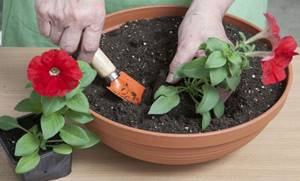
When planting seedlings, many novice gardeners try to place them “thicker” in order to get more lush bushes. Petunia, like most nightshades, has a powerful branched root system, which requires “space” and an abundance of nutrients for normal development. Therefore, the more pieces you plant in a pot, the faster they will die. In a container with a volume of 3.5 liters, 2, maximum 3 sprouts can be adjacent.
Petunia care
The plant is drought-resistant, but if there is a lack of moisture for a long time, it needs watering. Tolerates heavy soil moisture, but suffers from stagnation. Large-flowered forms are more demanding of heat, nutritional conditions and moisture than small-flowered forms.
Fertilizing is the main condition for lush, long-term flowering of petunia, so fertilizing should be done regularly, starting one week after planting and until the beginning of September with an interval of 10 days.
Lush flowering of petunias is ensured by complex fertilizers with increased potassium. Fertilizing with organic fertilizers gives excellent results. Constant feeding lasts until flowering is completed.

You need to take more care of petunias that are planted in containers: containers, balcony boxes, flowerpots. They need nutritious soil, consisting of peat, humus, leaf and turf soil, and sand.
Plant petunia seedlings very tightly in containers. Surfinias and ampelous petunias are planted in hanging baskets, tall vases and balcony boxes. To achieve lush growth and long flowering in these plants, they need to be watered often and fed once a week. If growth and lush flowering are inhibited due to bad weather conditions, treatment with a growth stimulator (Zircon and Epin-Extra) gives excellent results.
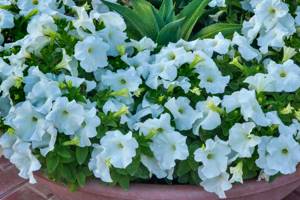
Rain causes great harm to petunias. During heavy rains, water droplets tear the petals. Petunia flowers become ugly, and the plant itself becomes sloppy. With prolonged rains, petunias may completely lose their decorative effect and even stop blooming.
Therefore, try to move the baskets with petunias under cover before the rain
Blooming petunia should be watered carefully, right to the root, trying not to damage the beautiful flowers.
Ampelous petunias suffer greatly from winds, so baskets with them should be placed in places protected from rain and winds.
In double and large-flowered forms of petunias, the appearance can be spoiled by faded flowers. They are practically invisible in large areas, but they can be seen in flower pots and small flower beds. To improve decorativeness, faded flowers are removed.
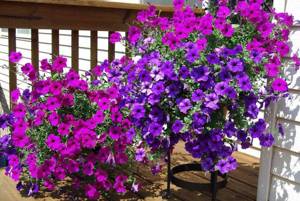
Petunia propagation
Usually seeds. In indoor conditions, growing petunia seedlings is complicated by a lack of light, so for sowing it is necessary to take seeds with a reserve. The sooner you sow the seeds, the sooner the plants will bloom. If you have the opportunity to give the seedlings light, then you can sow in February.
In simple conditions, it is optimal to sow at the end of March. The second difficulty is the soil in which the seeds will be placed and maintaining optimal humidity. Petunia seeds need loose and nutritious soil. It is advisable to sift the thick top layer so that the seeds lie evenly on the soil.

Next, spray, cover with glass and leave at a temperature of 23 ° C. On the 7th day, shoots will appear that need special attention. When the seedlings grow up and the first leaf appears, you can remove the glass. Petunias should be planted in a permanent location after the end of frost.
Small-flowered petunia blooms 70 days after sowing, large-flowered petunia varieties bloom 15 days later. Varieties of petunias with double flowers when propagated by seed produce 40% double plants, so they are most often propagated by cuttings, which are kept in greenhouses at a temperature of 12°C in winter.
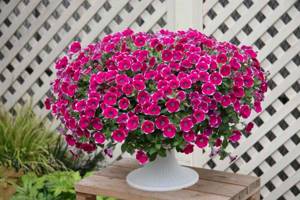
In central Russia, petunias are planted in May. The plant is very heat-loving; modern varieties of petunias tolerate cold spells and even short-term frosts. Flowering petunia seedlings can be planted in flowerpots, flower beds, or on the balcony in early May.
It is best to plant seedlings in the evening or on cloudy days, watering the pots with water well in advance. The distance between petunias depends on the variety. For multi-flowered petunia, the distance between plants should be 15 cm, for large-flowered petunia 20 cm, and for ampelous petunia 30 cm. After planting the seedlings, it is watered and the soil is mulched with humus or peat or.
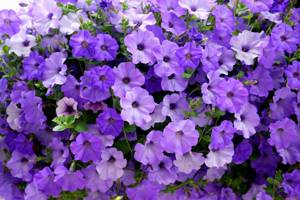
Growing ampelous petunia from seedlings
Bacopa Ampelnaya - care and cultivation at home
Before you start breeding these plants, you need to thoroughly study the issue of ampel petunia cultivation and care (you can use the Internet). After this, you can go to the flower shop to buy seedlings.
In order for planting material to be accepted and develop well, it is necessary to adhere to the recommendations of experienced gardeners:
- Seedlings should be planted in the evening, when there is no longer scorching sunlight.
- The seedlings are planted in the flowerbed along with the earthen ball in which they sprouted in the pot.
- The size of the hole should be no less than 10x10 cm.
- Bushes of ampelous petunia are planted at a distance of about 30 cm from each other.
- The soil around the seedlings is mulched with humus or peat. This will help protect the plants from low temperatures.
- Planted flowers must be watered.
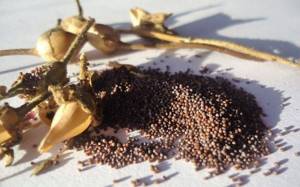
Petunia in landscape design
How to plant ampelous petunia in a flowerpot
In order for petunia to feel good in a flower pot, you need to choose the right soil for it. To do this, mix turf soil with peat in equal quantities and add 3 times less baking powder to them. If there is no opportunity or desire to prepare the soil for the plant yourself, then you can buy it ready-made in the store. An ampelous petunia planted in a pot needs evening and morning watering.
When planting petunias in pots, care and cultivation are carried out according to the same rules as in open ground, but there are some nuances:
- the ampelous beauty is planted not in the center, but at the edge of the pot;
- hang the pots in a well-lit place; in the shade, the petunia will not throw out buds and will stop growing;
- Do not place the plant in drafts.
Important! During prolonged rains, petunia should be placed under a canopy, since the ampelous beauty does not like waterlogging. When the cold weather sets in, you need to bring the pots with plants indoors. This will help extend the flowering period of petunia.
Pot volume for ampelous petunia
If we are talking about terry varieties, then a pot of about 3 liters is enough for them, and for other hanging species, about 5 liters should be needed per plant.
The number of petunias in a pot depends on its size. In a pot with a diameter of 30 cm you can plant no more than 3 plants. There is no need to allow thick planting, otherwise the flowers will begin to hurt and will not develop well. Petunia is one of those flowers that need space.
For ampelous petunia, both hanging plastic pots and flowerpots with high legs are chosen. The main thing is that they have holes for water drainage, since these varieties need abundant watering.
Important! When choosing hanging flowerpots, you should definitely pay attention to the presence of a tray so that water does not pour in a stream onto the heads of passers-by.
Proper care and nutrition for petunias
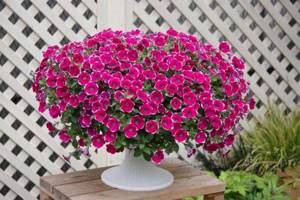
Ampelous petunia can delight everyone with delightful flowers. However, you can get beautiful flowers if you properly grow them from seeds at home. Immediately after you have transplanted the petunia sprouts to their permanent place of residence, feel free to start giving it food (after 2 weeks). Carry out the fertilizing process simultaneously with watering. Here is an approximate nutrition plan for petunias:
- In the first week: fertilize with water with humatomi;
- In the second week: fertilize with water and potassium sulfate.
- And then we alternate every week.
On a note. A very important fact is the timely detection of petunia disease. As soon as you discover diseases such as powdery mildew or other pests, immediately spray the plant with an appropriate solution. The spraying process comes down not only to treating the top of the bush; it is also necessary to treat the bottom, lifting the leaves. And our advice to you, do not forget to remove flowers that have already wilted (every week).
Petunia brings aesthetic pleasure to its owners with its variety of bright colors throughout the summer and almost until the weather gets colder. And with all this, it does not require special efforts in courtship. If the air temperature drops to -30 degrees, pots of petunias should be brought into the house. Plant these beautiful flowers on your balcony or in your country house and you will be able to experience all the delight of the garden.
Good luck to you!!!
How and when to plant ampelous petunia with seeds - video
Feed the petunia and lush flowering is guaranteed - video
Ampelous petunia will become a real assistant to the gardener and will help make the area beautiful and landscaped. Any house or flower garden will shine with a variety of beautiful colors and shades only if all cultural requirements are met, with great attention to plants and hard work. Growing and caring for ampelous petunia at home will not take much time and can be done even by a gardener with little experience.
Reasons why petunias don't bloom
For lush flowering, it is not enough to plant plants on time. There are a number of reasons why petunias do not feel well:
- nutrient imbalance. You should carefully read the instructions for using fertilizers. It’s better not to add a little than to overdo it;
- if the shoots have a dull, thinning appearance, then most likely there is not enough sunlight;
- improper watering regime can also cause the buds to drop.
When choosing a plant, you should take into account the style and design of the interior, and also pay attention to the color scheme. There can be several varieties in one container
Species of other flowers may also coexist, for example, fern, lobelia, hosta.
As a result of all this information, it becomes clear that ampelous petunias are quite unpretentious flowers that are characterized by long flowering. There is a large selection of varieties and varieties. This plant can be grown not only by professionals, but also by beginners in gardening.
Caring for a dwarf beauty
This series of flowers can be grown in pots and balcony boxes; a place in flower beds is also quite suitable. The plant is sown for seedlings in February - April.
When purchasing seeds, please note that they are in granules. Coated with an easily soluble composition that simplifies the process of sowing and growing. The granules must be placed on the surface of a substrate that has been slightly compacted and spilled with water.
Afterwards there is abundant moistening from a sprayer and the pots are covered with glass. The seed coat should not be allowed to dry out. The first shoots can be seen in 1.5-2 weeks if the room temperature is maintained at 22-24 ° C and with sufficient lighting. Direct sunlight on the pots is unacceptable. Seedlings need to be moistened and picked at the growth stage, when 2-3 true leaves have already formed. After diving, it is necessary to fertilize with a complex fertilizer containing iron and microelements for the rapid formation of roots and accelerating the flowering process. The timing of flowering can be influenced by changing the length of daylight hours. The best temperature for plant growth and development will be considered 16-18°C. Seedlings are placed in the ground only after the end of frost. The most suitable soil for this variety is light, fertile, sufficiently drained, and receives sunlight for a long time. The place must be protected from the wind.
Further care
The sprouts begin to sprout in about a week. During this time, the container should be ventilated for 20-30 minutes. in a day. When seedlings appear, you can begin to ventilate twice a day.
It should be taken into account that seeds of different varieties of petunias may germinate at different times. It is necessary to read the instructions in advance, which are usually written on the packaging.
When caring for seedlings, the following conditions must be observed:
- monitor the light regime, but shade from direct sunlight;
- Make sure the soil is always slightly moist. Gently pour water at room temperature;
- ventilate. At this time you can spray;
- for hardening, it is enough to take the boxes with seedlings outside for 20-30 minutes;
- remove condensation from the lid of the container.
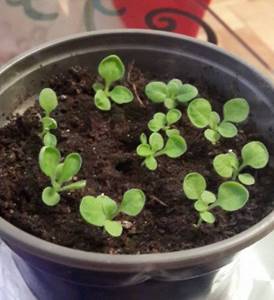
When the seedlings have three leaves, they are planted in separate containers. It is advisable to do this with a small lump of soil around the roots to avoid injury to them. To relieve stress during transplantation and improve growth afterwards, you can treat petunias with the biological product HB-101 or Epin.
At this time, the air temperature is gradually reduced to 18°C. Watering is reduced until the top layer of soil dries slightly. Gradually increase ventilation, thus hardening the seedlings
The soil is carefully loosened so that a crust does not form. The container is periodically turned around so that the plant develops correctly and does not turn out to be one-sided.
Description of the species
Petunia belongs to the nightshade family and is a herbaceous or subshrub flowering plant that occurs as both an annual and perennial. The stems are erect, and in some varieties they are creeping. The leaves are soft, whole, light green, pubescent. The flowers are large, small, bell-shaped, double, one- and two-color. Flowering can begin from the end of May and continues until the first autumn frosts. The fruit is a small capsule with very small seeds. The plant is thermophilic and grows in well-lit areas. It is not particularly demanding on the soil, but prefers sandy, fertile places. It is quite drought-resistant, but can also grow in moist soil if there is no stagnation of water.
The main advantage of growing any variety of petunias is their abundant flowering and absolute unpretentiousness. What other flower can boast such a variety of sizes, shapes, colors and bud colors?
Today, a huge variety of terry, low-growing, large-flowered and small-flowered species are known. The cascading or ampelous petunia is noted for its special beauty and splendor.
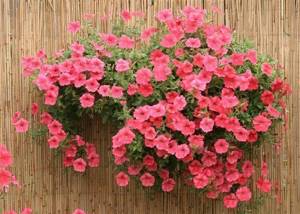
Their variety of colors allows you to create real living pictures, because now, in addition to traditional pink, purple and white flowers, there are purple, yellow, bright red, salmon and coral colors, lilac and blue, soft cream and blue. Some may find two-color petunias interesting: white with a purple stripe, bright flowers with a ruffled light border, or white and red star-shaped flowers.
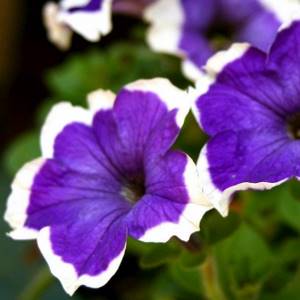
Thanks to this diversity, petunias are grown in open ground as ground cover plants, as borders for flower beds, and used in garden beds, on alpine hills, and for decorating recreation areas, garden ponds and flower beds. Cascade petunia, planted in hanging pots or containers, decorates balconies, terraces and gazebos. Bright flowers of ampelous varieties look beautiful on hedges, pergolas or arches. Petunias are also quite successfully grown as indoor plants.
Popular varieties
In Russia, the following flower varieties are most popular.
Easy Wave
Translated from English as “light wave”. The variety was bred in the USA. This is an unpretentious plant that is distinguished by rich and long flowering almost all summer. Flowers are 7 cm in diameter with a faint aroma. Easy Wave rises 20-30 cm above the ground and then falls to a meter in length.
Subspecies of the variety:
- shoots of Easy Burgundy, with two-color corollas, reach 2 m;
- Yellow looks relatively compact. It is a spherical bush with yellow-white flowers;
- Red Velor blooms with red velvet flowers with dark veins on the petals and a black center;
- Palm Vane has lavender buds.
Opera
It is unpretentious in care, has well-developed branching at the base of the shoot. The flowers are 5-6 cm, located along the entire stem. The vines grow up to 100 cm. In a hanging basket it most often has a spherical, dense shape.
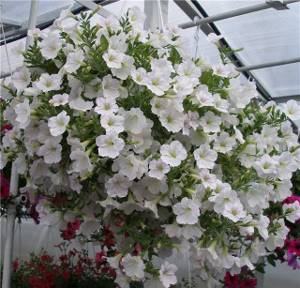
Petunia Opera White
Other subspecies:
- Terry corollas of the Blue variety are painted bright blue. With a long flowering period;
- Parple features numerous purple, violet-crimson flowers;
- As an adult, coral takes on a dome shape. Blooms in coral tones;
- White is famous for the snow-white color of its petals, which delight the eye for 5 months.
Rapunzel
This plant is up to 80 cm in length. At a young age, the shoots are erect, but as they grow they begin to droop. Over time, a spreading cascade of red or white color grows. The diameter of the corolla with simple petals is up to 8 cm. Flowering from June to early autumn.
Success
Translated from English it means “success”. The average size of the lashes is 70 cm. Early large flowers appear in large numbers together. Flowering occurs evenly. The flower is resistant to bad weather.
Avalanche
This is an early flowering petunia with giant flowers up to 10 cm in size. The stems grow up to 45-50 cm. The shoots are thin with small leaves. Petunia ampelous Avalanche white is popular. During flowering, its snow-white corollas with a yellow center densely cover the stems. The plant does not require care. The flowering period of white ampelous petunia is from early summer to mid-autumn. Another variety of the variety is Purple Avalanche. The peduncles are colored lilac-violet with a darker core.
Crazytunia Mandevilla
Belongs to the Craisitunia series. It is distinguished by its spherical shape and special coloring of flowers. The petals have a velvety dark red color with a yellow vein. The shape of the corolla resembles a lily. It begins to bloom so abundantly in May that the greenery is practically invisible. Compared to most other hanging varieties, the bush looks taller (up to 40 cm) and denser.
Starry Sky
This new product was developed by German breeders in 2015. The vines grow up to 1 m and are highly branched. Flowering is long lasting. The name of the variety accurately conveys what its flowers look like. The corollas are painted in an intense blue-violet color, on which white spots are scattered like stars. The flowers have a corduroy texture. This coloring is very similar to space. Despite its recent origin, this variety has already become very popular among gardeners.
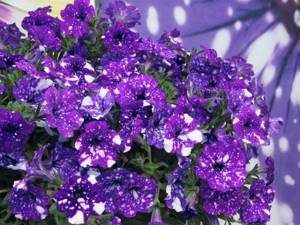
Petunia Starry Sky
Big Time overhead
A compact bush with lush blooming pink buds of simple petals. The plant is characterized by fairly good endurance. Unlike many of its relatives, it has small shoots. As a result of branching, it forms a spherical shape.
What does it mean: brief description
The plant is remembered for its extraordinary flower stalks and unusual color options.
The shoots grow up to 1.2 m in length. In rare cases, the shoot can be up to 30 cm in length. The main feature is the stems creeping along the ground. The foliage is soft, slightly pubescent on top. With age, the leaves also increase in size. Flowers are formed in each axil. One bosom - one flower. They look like bells in appearance. There are a wide variety of colors - from white with a milky tint to exotic ones.
Popular varieties: names, descriptions and photos
Petunia has several dozen varieties. They all differ in appearance, color, and growing conditions. There are three types of petunia:
- Cascade.
- Ampelous.
- Bush.
Ampelous petunia, with its appearance during flowering, is the most beautiful of the existing plant species.
Popular varieties of ampelous petunia are as follows.
Easy wave
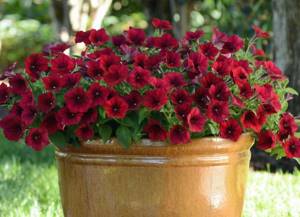
The lashes reach a length of up to one meter.
When grown in pots, at least 8 liters of soil is required.
Due to the abundance of flowers, the foliage is practically invisible. By providing active additional lighting, you can enjoy flowering until the cold weather.
Surfinia
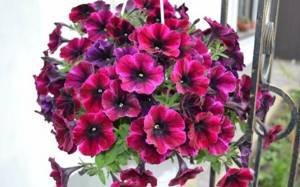
The group is resistant to adverse weather conditions. It is characterized by rapid growth of shoots . Characterized by a variety of colors.
The Snow Queen
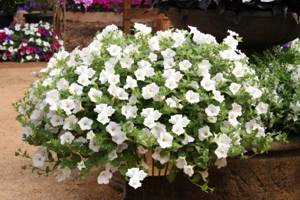
In the flowering phase, the plant resembles a snow-white waterfall of flowers with a diameter of 7–10 cm. Suitable for growing in open ground, apartments, or flowerpots. Shoots grow up to 80 cm in length.
Abundant flowering is achieved with sufficient lighting.
Opera Supreme
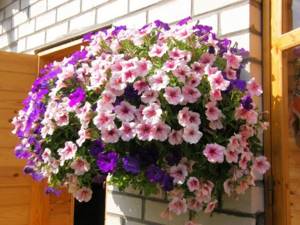
Available in snow-white, pink, coral and blue shades. The stems reach 1 m in length. They are unpretentious to living conditions . Suitable for open areas and hanging pots.
Svetlana
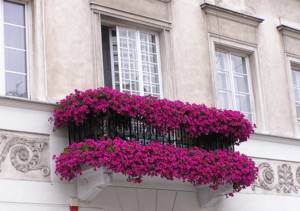
Shoots are up to 1 m long. The flowers are pink, up to 5 cm in diameter. They need a lot of sunlight and warmth. Used to decorate loggias and balconies.
Difference from cascade and bush varieties
Ampelous and cascading petunias have much in common, however, with a detailed comparison, you can see that these varieties are different, and here is their difference:
- Shoots of different lengths. Stems are pinched only in cascading species.
- Shoots of varying strength. The cascade group of flowers is characterized by succulent and flexible stems.
- Ampel ones are intended more for hanging flowerpots, while cascading ones cover the soil well.
- Cascade petunia is characterized by buds of the same color and size throughout the plant. Ampelous varieties on one plant can have flowers of different sizes and colors.
Bush varieties are easy to distinguish from hanging petunias. The height of the bushes is no more than 30 cm. The stems grow upward, unlike the hanging ones. There are no differences in small seedlings. With the appearance of the first shoots, it becomes clear that the seedlings belong to bush or hanging petunia.
The hanging varieties begin to produce side shoots. The appearance of the seedlings resembles a bush without a main stem.
Bush varieties begin growth from the main shoot. Lateral stems begin to form after pinching or the appearance of the first flowers.
Bush petunias
The most numerous subgroup of petunias. Includes many varieties with bright, large flowers in a wide variety of shades.
Bush variety of petunia
Daddy
The Daddy variety is distinguished by the presence of a large number of flowers. The height of the plant reaches 25 cm. The variety is resistant to the vagaries of nature: Petunia Daddy is not afraid of dry weather, rain and wind. Loves the sun. The plant is grown both in open flower beds and on balconies in special containers. The shade of the petals is varied: white, blue, hot pink, red and other colors.
Variety Daddy
Picoti
One of the most popular varieties. Its peculiarity is the presence of a white edging on the petals, which gives the flowers an elegant look. The bushes grow up to 25 cm in height. The flowers are large, of various shades. Pikoti is not afraid of wind and heavy rains. The flowering period is very long - all summer until the onset of autumn frosts. Suitable for growing in open ground and in boxes and flowerpots.
Picotea with elegant petal edging
Storm
A large-flowered variety that will be an excellent decoration for a balcony, garden or home. High humidity is not a problem for plants of this variety, so Storm can be planted in the country without fear that gray rot will appear on the flowers due to a damp, rainy summer. The bush grows up to 35 cm. The plant is demanding on the composition of the soil: it must be saturated with nutrients.
Variety “Storm” with large flowers
Polaris
One of the new varieties bred by breeders. Polaris is resistant to hot, rainy weather and wind. Petunia Polaris is characterized by rapid growth and reaches 30 cm in height. It begins to bloom early, the plant has a large number of flowers that hide long shoots.
Triumph
The height of the stems of Petunia Triumph is about 60 cm. It has giant flowers, the diameter of which can reach 16 cm. It is distinguished by corrugated petals of pink color from light to dark shades, the edges of which are fringed. The center of the flower is much darker than the edges, the petals are decorated with stripes. The Triumph variety is not resistant to prolonged rains.
Original Triumph
Ultra variety
Characterized by large, wide-open flowers. It will decorate any garden; Petunia Ultra is especially suitable for decorating large flower beds.
The Ultra variety will become a real decoration of the flower garden
Limbo
The variety is classified as low-growing: the height and width of the bush of this petunia is 20 cm. Despite its modest growth, the diameter of the flowers reaches 12 cm. Limbo begins to bloom early and abundantly, the flower is resistant to atmospheric influences. The variety of shades is very wide: white, pink, purple, violet, silver, peach and many others.
Large-flowered variety Limbo
Planting and caring for ampelous petunia throughout the summer and winter
Planting ampelous petunia is also possible using cuttings from the mother plant. those. It is enough to sow a variety once with seeds in order to then be able to propagate it using cuttings. As a rule, cuttings are harvested in February-March from overwintered plants.
Care during the winter consists of ensuring a dormant period, for this purpose they reduce the ambient temperature, reduce the amount of watering and ensure the supply of phosphorus and potassium to the soil for the subsequent formation of flower buds.
In a room in winter, petunia must be regularly sprayed with water at room temperature. This should be done at least once a day.
Caring for ampelous petunia throughout the summer consists of regularly loosening the top layer of soil and applying mineral complex and organic fertilizers. Pruning is carried out only for the purpose of forming a beautiful bush shape.
Be sure to remove all faded buds - this measure stimulates the splendor of flowering. All dried branches and flower stalks are also regularly trimmed.
When planting ampelous petunia, choose the right container. This plant has a powerful root system. For 1 seedling a volume of 6 to 10 liters is required. It is not recommended to plant 2 or more bushes in 1 container. They will interfere with each other's proper development.
Proper planting and care of petunia ensure long and abundant flowering. But for this you need to know the basic rules.
First of all, pay attention to the soil - it should be light and structural, rich in organic and mineral substances. A 3 cm layer of drainage is poured onto the bottom of the container.
Before planting, prepare a hole, which is spilled abundantly with water.
After installing the peat pot (which can be removed without damaging the root system), soil is added to the side.
Regular feeding with fertilizers with a predominance of magnesium and potassium is required. This is necessary for vigorous flowering. In the morning and evening, the plant is sprayed with water from a spray bottle.
However, during the flowering period, this procedure should be carried out very carefully, try not to get water on the petals and buds
Care in summer so that it blooms profusely
An adult petunia drinks a lot, so in the summer it will need daily watering. With a lack of moisture, the plant withers and a sticky coating of essential oils appears on the leaves. Petunia that regularly suffers from drying out produces fewer buds.
For full flowering, the plant needs bright, diffused light; do not place the pots in the shade. Ampelous petunia responds well to feeding. It is fertilized three times a month with mixtures for flowering plants. Another secret to abundant flowering is the timely removal of faded buds along with the pedicels.
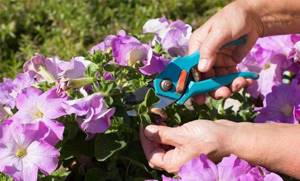
Possible difficulties and problems
This variety of petunia is easy to care for, but is often attacked by diseases:
- Blackleg. Damages young cuttings. Develops in conditions of high humidity and lack of ventilation. It spreads quickly, moving from plant to plant. In cuttings, the stem at the base turns black, rots, and the plants lie down.
- Powdery mildew. Appears on young leaves and stems, covering them in the form of a dirty white coating.
- Gray rot. The stems and leaves are covered with gray fluffy spots. The cause of the disease may be insufficient lighting, excess nitrogen and high air humidity.
Among the pests that are dangerous for vegetative petunia:
- Aphid. The insect populations are large and damage leaves and flowers. The plants become covered with a sticky liquid called aphid secretions.
- Whitefly. This greenhouse insect lands on flowers along with soil and new planting material. The adult looks like a small white butterfly. Larvae and adults cause damage by eating the leaf mass.
- Spider mite. Active in dry years and hot, dry areas. Affected leaves appear gray. A network of dots is visible on the surface of the leaf - traces of insect punctures.
For control, insecticides are used against a complex of pests. More gentle at home - “Fitoverm” (ampoule / 1–2 liters of water). In open ground, use “Actellik”, “Aktara” or “Inta-vir”, diluting the drugs according to the instructions.
Vegetative petunia is a beautiful crop for decorating cottages and city parks. Minimal care and the ability to quickly propagate it make this crop very promising in landscape design. This petunia is hardier than its hybrid relative and is not afraid of rainy weather.
The nuances of growing in pots and flowerpots
- Petunia is very demanding on the amount of light. In winter and autumn, you will have to provide the plant with additional artificial lighting.
- The plant cannot withstand stagnant moisture. If you allow the soil to become waterlogged, you will soon notice that the flower begins to hurt. He will not last long with such care and will die. This problem is quite common when growing in pots, so try to regulate the humidity level.
- Despite the fact that stagnation of moisture is detrimental to petunia, it loves high air humidity. Dry air can lead to a decrease in the plant's immunity and its increased vulnerability to attacks by spider mites and powdery mildew.
- Unfortunately, at home, petunia cannot form lush inflorescences all year round (although it blooms at home no worse than in the garden). The plant goes into hibernation around mid-November and sleeps until early February.
- If the flower feels good, it is comfortable and convenient, it will bloom from February to October, so you should not disturb it by stimulating it earlier than these dates.
Important! Bush varieties of petunias are best suited for indoor growing, but ampel plant varieties are suitable for balconies and hanging flowerpots
How is it different from cascade?
An important feature of cascade petunia is that this varietal group also has creeping stems. Sometimes the name "semi-ampel" group of varieties is found
It is extremely in demand by domestic gardeners and decorators. “La Gioconda” may turn out to be especially attractive. It produces flowers colored in different tones that form a ball.
A giant flower cap develops almost from the very root. The gravity of this cluster is so great that it falls to the ground from its own gravity. Botanists have established that cascading petunias are a type of ampelous group. They develop strong, elastic shoots. The main stem can be directed both upward and to the sides.
If in pure hanging varieties the length of shoots reaches only 1.5 m, then in cascade varieties they can be up to 2 m. At the same time, the thickness of the shoot also increases. Additionally, its strong growth is noted.
Ampelous plants are covered with flowers profusely, as has already been noted. Cascading flowers may produce fewer flowers, but they are larger in size, and in addition they can have different colors on the same plant. The difference in plant characteristics also dictates a different approach to cultivation. Those who decide to start a hanging petunia can get by with a modest container.
Cascade ones require a much larger tank (minimum capacity 5 liters). Accordingly, you will need either hanging flower pots or flower beds (as an option - large stationary flowerpots and supports). If the plant can only direct its shoots downward, it will have to be pinched. If the shoots can be oriented in different directions, pinching will only slow down growth, weakening the bush itself.
Care instructions
At home
To keep your petunia healthy and blooming well, you should follow some rules:
- Pot with drainage hole – one plant – 3 liters of soil.
- Temperature: 18-20 degrees (If the plant is on an open-air balcony, you should take the plant away before it rains).
- Watering is carried out strictly at the root, so as not to damage the flowers of delicate petunia. In summer, twice a day, the next day after watering, you need to loosen the soil.
- Regular feeding determines the beauty and duration of flowering. Liquid fertilizers - 2-3 times a week.
- Removing dried flowers and leaves stimulates the growth of new buds.
- By summer, the flowering process slows down - in order to give the plant splendor, you need to trim the top around 4-5 leaves.
You will find all the details about caring for petunia in this article.
Sowing seeds for growing in open ground
- Use plant seeds.
- For sowing, use a box covered with film and place it in a warm place.
- After the first germination, without removing the film, place the box in the light.
- After the first leaves appear, we transplant them into the ground.
- The distance between plants in the ground is 20-25 cm.
- Add fertilizers to the soil - humus, lime.
- Feeding - 2-3 times a week.
- Removing dried leaves and flowers will give strength to the plant and stimulate flowering.
Reproduction
Petunia is most often propagated by seeds. You can collect them from your flowers yourself (they have time to ripen in the middle zone) or buy them in a store.
Petunia seeds are very small, sometimes seed producers process them. Dried seeds are easier to sow; their coating of fertilizer allows the plant to receive nutrition as soon as the sprout appears.
To enjoy flowering longer, petunia is sown early - at the end of January or February. The soil is prepared from a mixture of peat, sand, and turf humus. Petunia can be sown in boxes or directly in separate pots, peat tablets.
Important! The seeds are laid out on the surface of the soil without covering them with soil!
Some gardeners practice sowing petunias in snow, sowing seeds on a layer of snow laid on seedling soil. This method helps to distribute the seeds evenly (dark seeds are clearly visible on white snow). The snow, gradually melting, feeds the seeds with useful melt water.
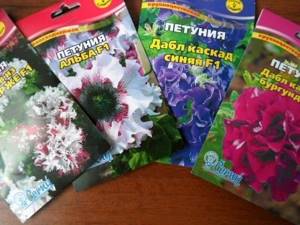
Seeds
Before germination, the crops are kept covered with film or glass in a warm place. After the emergence of seedlings, the shelter is removed gradually, accustoming the seedlings to fresh air.
Caring for seedlings consists of watering, loosening and picking in the phase of 4 - 5 true leaves. Until the beginning of April, planting petunias must be supplemented with light, extending the daylight hours to 11 hours. During the growing of seedlings, they are fed twice:
- a week after germination with nitrogen fertilizer;
- after picking - potassium.
Petunia is planted in the ground only when the weather is warm. Lowering the temperature to 0 degrees can destroy a delicate plant.
The distance between petunia bushes is maintained at least 30 cm for compact forms, and at least 60 cm for large ones. There is a vegetative way to propagate petunia - cuttings. It is used for varieties that do not retain their qualities when propagated by seed.
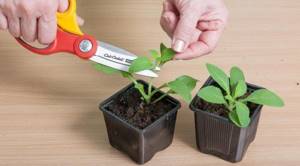
Seedling
The mother plant is placed in a spacious pot in the fall and stored in a bright and cool (temperature +14 +18 degrees) room. Petunia is not fed and watered not often.
By March, the bush is brought into a warm place, watering is increased, and nitrogen fertilizing is applied. When stepsons actively grow on a plant, they are cut off and rooted. The cuttings are dusted with Kornevin or Heteroauxin, and the branches are placed in damp sand or vermiculite. The top of the container with cuttings is covered with a greenhouse.
The cuttings are regularly ventilated or the soil is watered moderately. After 2 - 3 weeks, a good root beard will form on the seedlings. Seedlings from cuttings are planted in a flowerbed in the same way as plants obtained from seeds.
Petunia propagation by cuttings
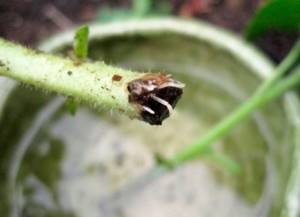
Propagation by cuttings is suitable only for double and ampelous petunias, as well as for all cultivar groups of mini-petunias (calibrachoa). Terry varieties can be propagated by cuttings in the last weeks of winter, the first weeks in spring, while mini-petunias and ampelous ones can be propagated all year round, but for this they will need additional illumination with fluorescent lamps, as well as warmth (from 21 to 24 degrees).
Cut the apical cuttings, which should have 4 to 6 leaf blades. Tear off all the leaves except the top two. The remaining leaves should be shortened by ½ part. The cuttings need to be planted for rooting in the same soil mixture that is used for seedlings. However, in this case, the surface of the substrate should be covered with a layer of perlite or sand 20–25 mm thick, which must be spilled with a fungicide solution. A distance of 15–20 mm must be maintained between the cuttings, and the container is covered with glass on top.
It is unnecessary to use growth stimulating agents (for example, Heteroauxin), because freshly cut cuttings take root well, but you should not delay planting them. The substrate in the greenhouse should be slightly damp at all times; for this, the petunia needs to be moistened twice a day with a spray bottle. However, it should be noted that excessive dampness contributes to the development of “blackleg” or mold. Terry and ampelous petunia will take root completely after approximately 7 days, and mini-petunia after 14 days.
After the roots reach 10–15 mm in length, the plants must be planted in individual pots, the diameter of which should be 50 mm. In order for the plants to bush more strongly, they must be pinched above the 4 or 5 leaf plate. The tops of the stems remaining after pinching can be used as cuttings.
After half a month, if necessary, the stems are pinched again. After 6 weeks, such plants are transplanted into pots whose diameter reaches 11–13 centimeters. You need to care for growing cuttings in almost the same way as seedlings. However, it must be taken into account that ampelous petunia and mini-petunia require a lot of free space, and therefore it is recommended to hang the containers with them.
Collecting seeds
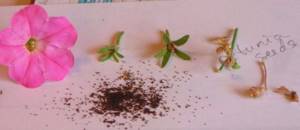
Seeds should be collected only after they have fully ripened on the bush. During the flowering period, you should mark the bushes of those varieties from which you will need to collect seeds. It should be noted that the lower buds are used to collect seeds, because in them the seeds form and ripen faster. After the bud is fully formed, you should wait 8 weeks; after this time, the seeds in them will fully ripen. The seeds of such a plant are small (diameter approximately half a millimeter), there are approximately 100 of them in one box.
Shake the ripened seeds out of the boxes and distribute them into bags, do not forget to label the year of collection, variety and color of the flower. You can also simply cut the boxes and place them in storage at home. The seeds need to be ripened; to do this, they are stored at room temperature for 3–4 months. If the seeds are stored correctly, they remain viable for up to four years.
